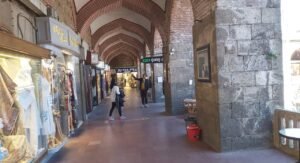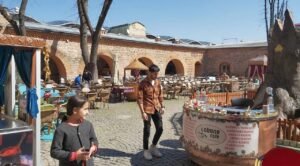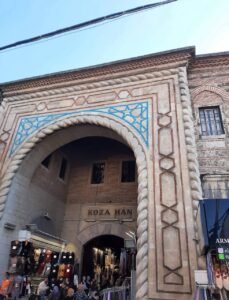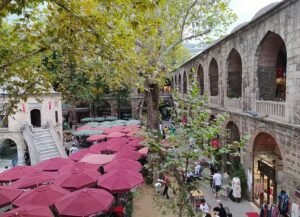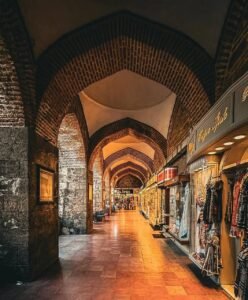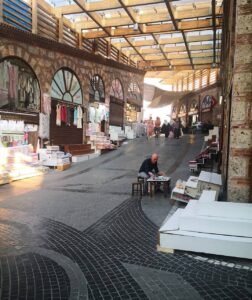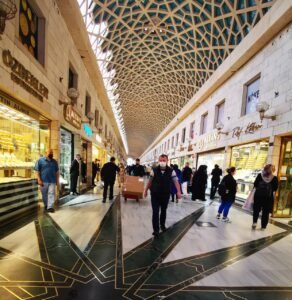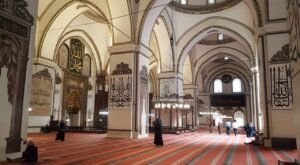Description
Koza Han: The Silk Heart of Bursa, Turkey
Tucked away in the heart of Bursa, one of Turkey’s most historically rich cities, lies a hidden gem of Ottoman architecture and heritage — Koza Han. Often overshadowed by Istanbul’s grandeur or Cappadocia’s surreal landscapes, Bursa has long been a cradle of culture, trade, and craftsmanship. And at its center, Koza Han stands as a vibrant reminder of the city’s golden age in the silk trade. More than just a shopping destination, Koza Han is a living museum where the past and present gracefully intertwine.
A Legacy of Silk and Commerce
Built in 1491 under the order of Sultan Bayezid II, Koza Han was designed as a center for the silk trade, a key industry in Bursa during the Ottoman Empire. The name Koza translates to “cocoon” in Turkish — a direct nod to the silkworm cocoons that were once traded here in bulk.
The architect of Koza Han, Abdullah bin Pulat Şah, designed the han (caravanserai) not only as a market but also as a place for traveling merchants to rest and conduct business. It was part of a broader charitable complex (külliye) that included a mosque and schools, with the rental income from the han used to support religious and educational institutions in Istanbul. This interconnectedness between trade, spirituality, and social welfare was a hallmark of Ottoman urban planning.
Architectural Charm
Koza Han's architectural design is a beautiful example of Ottoman commercial architecture. It has a rectangular layout with two stories surrounding a central courtyard. The lower floor once served as stables and storage areas, while the upper floor hosted more refined shops and guest rooms for traders.
At the center of the courtyard stands a small octagonal mosque, accessible via a short staircase. This structure served the spiritual needs of the merchants and still functions today, adding a serene focal point to the hustle and bustle of modern commerce.
The courtyard, shaded by centuries-old plane trees, is perhaps Koza Han’s most iconic feature. Lined with tea houses and cafés, it offers a peaceful escape from the city streets. Locals and tourists alike gather here to sip Turkish tea, admire the elegant arches, and enjoy the ever-present murmur of daily life.
A Living Market
Today, Koza Han is no longer a major silk trade hub, but it still honors its legacy. Inside, visitors will find a wide range of shops specializing in silk scarves, shawls, textiles, and other handmade goods. Many of the products are still made using traditional techniques passed down through generations.
Bursa silk is especially prized for its fine texture and vibrant dyes, and Koza Han remains one of the best places in Turkey to purchase authentic silk items. Whether you're looking for a luxurious scarf, a decorative pillowcase, or a unique gift, the variety and quality here are unmatched.
Artisans are often on-site and happy to share their knowledge about the silk-making process — from raising silkworms to weaving and dyeing the fabric. This hands-on experience transforms a simple shopping trip into a cultural journey.
Cultural Significance
Beyond its economic history, Koza Han is deeply tied to the cultural fabric of Bursa. The han reflects Turkey’s Silk Road heritage, linking it to centuries of East-West trade and exchange. During its heyday, Koza Han was a vital meeting point for traders from Persia, China, India, and Europe.
Even today, the han attracts cultural enthusiasts, historians, and architects fascinated by its blend of functionality and beauty. It has also become a gathering place for locals — a setting for both business meetings and quiet conversations under the trees.
The han is especially lively during Bursa’s Silk and Textile Festival, held annually to celebrate the city’s historical connection to the industry. During this time, Koza Han becomes a stage for live performances, art exhibitions, and traditional demonstrations that bring the old-world charm to life.
How to Visit Koza Han
Koza Han is located in Bursa’s historic city center, just a short walk from other notable attractions like the Grand Mosque (Ulu Camii), the Covered Bazaar (Kapalı Çarşı), and the Green Tomb (Yeşil Türbe). This makes it an easy and rewarding stop on any walking tour of the old city.
The easiest way to reach Bursa from Istanbul is by ferry and bus, or via the new high-speed ferry to Mudanya, followed by a short taxi or bus ride. The han is open daily, generally from 8:00 AM to 7:00 PM, with most shops closed on Sundays.
It’s recommended to visit in the morning or late afternoon to avoid the midday crowds and enjoy a more relaxed atmosphere. Don’t forget to take a seat in one of the cafés, order a glass of Turkish tea or strong coffee, and simply watch the world go by.
Insider Tips
-
Haggle Respectfully: Bargaining is common in Koza Han, but always done with a smile. If you’re buying more than one item, ask for a discount.
-
Ask About Craftsmanship: Many shopkeepers are passionate about their work. Ask them to explain how their products are made — you might learn something fascinating.
-
Try the Local Cuisine: There are excellent restaurants nearby offering İskender kebab, one of Bursa’s most famous dishes.
-
Photography: The han is photogenic in all seasons, but the spring bloom and autumn leaves offer particularly stunning visuals.
-
Learn a Bit of Turkish: Even just a few words can go a long way in making connections with local vendors.
Final Thoughts
Koza Han is more than just a historical building — it’s a bridge between centuries, cultures, and people. Whether you're a history buff, a lover of fine textiles, or simply someone who enjoys authentic travel experiences, Koza Han offers a window into the spirit of old Bursa.
With its timeless beauty, vibrant commerce, and warm hospitality, this Ottoman silk market continues to weave stories — one thread at a time.
Location
-
Nalbantoğlu, Uzunçarşı Cd. No:59 D:42, 16010 Osmangazi̇/Bursa


